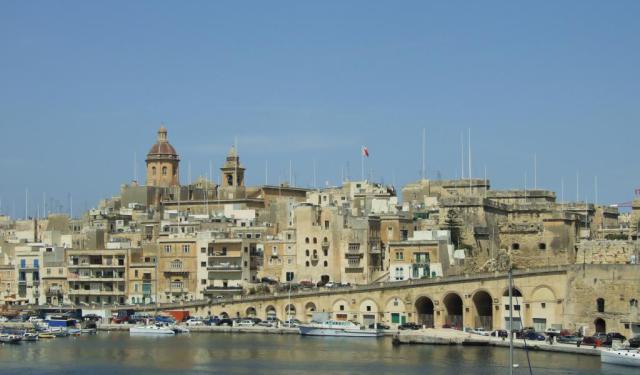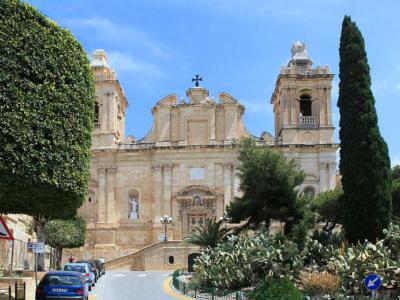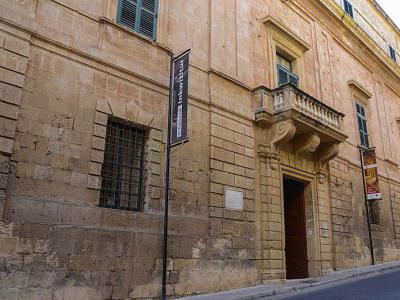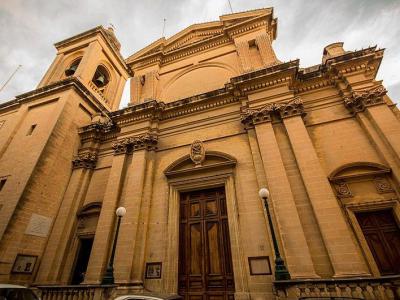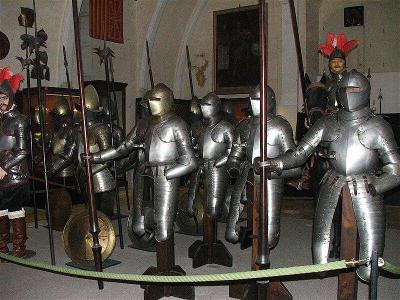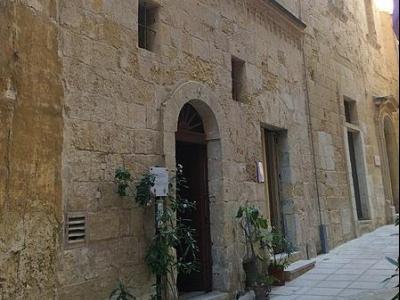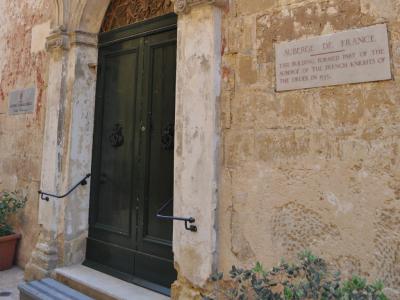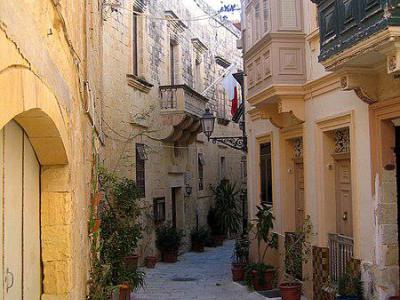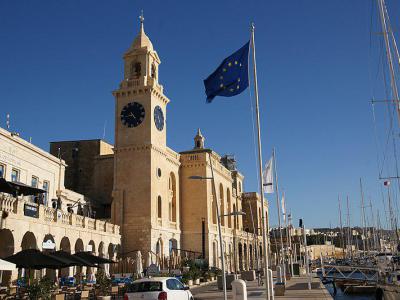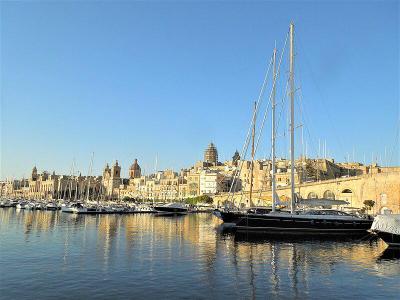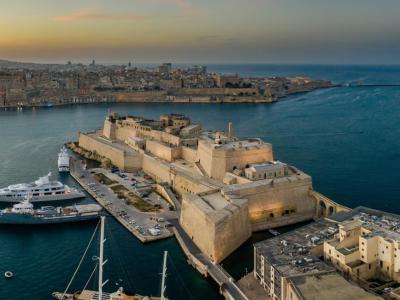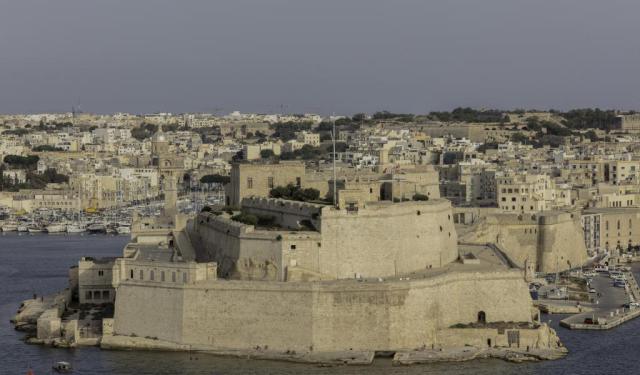Birgu Introduction Walking Tour (Self Guided), Birgu
Birgu, also known as "Victorious City", is an ancient fortified town on the southern shore of the Grand Harbour in the South Eastern Region of Malta. It occupies a prominent piece of land, with Fort Saint Angelo crowning its apex and the town of Cospicua resting at its base.
The name "Birgu" traces its roots to the Arabic word "Borgo," meaning a small town. Over the years, Birgu's history has been entwined with maritime, trade, and military activities. Its cobblestone streets reverberate with echoes of the tales of knights, emperors, and explorers – Phoenicians, Greeks, Romans, Byzantines, Arabs, Normans, Angevines, and Aragonese.
Before Valletta took the reins as the capital and primary city of Malta, Birgu served as the focal point for those seeking to control the Maltese archipelago. It was the headquarters of the Order of Saint John and effectively functioned as Malta's capital from 1530 to 1571. The town played a pivotal role during the Great Siege of Malta in 1565. After the siege, its importance waned when the knights moved their seat to Valletta.
Birgu endured French occupation, followed by British rule, from 1800 to 1979, when the Royal Navy established its base here. During World War II, the town suffered heavy bombing, resulting in the loss of historic landmarks. In recent years, an agreement with the Sovereign Military Order of Malta has seen their return to Fort Saint Angelo, preserving Birgu's heritage.
The historic Vittoriosa Waterfront is one of the town's top tourist attractions. It contains the former Palace of the General of the Galleys and the Order of Saint John's treasury.
Saint Lawrence's Church, another notable site, was once the Conventual Church of the Order and is dedicated to Saint Lawrence of Rome, whose feast day is very popular among locals. Other notable churches in town include the Our Lady of Annunciation Church, run by the Dominican Order.
Birgu also contains five Inns (Auberges) of the Knights, including the Inn of France (Auberge de France) and the Inn of England (Auberge d'Angleterre), in which the latter is the former home of the English Knights of Saint John on the island.
Birgu is a special locality to visit, whether by day or night. You may take pleasure in simply walking around its immaculate, narrow streets, lovingly decorated with potted plants. However, if you're a history enthusiast, Birgu, where every corner breathes history, can offer you a lot. Come and discover the beauty and heritage of this charming Maltese town, and let its timeless tales leave an indelible mark on your heart!
The name "Birgu" traces its roots to the Arabic word "Borgo," meaning a small town. Over the years, Birgu's history has been entwined with maritime, trade, and military activities. Its cobblestone streets reverberate with echoes of the tales of knights, emperors, and explorers – Phoenicians, Greeks, Romans, Byzantines, Arabs, Normans, Angevines, and Aragonese.
Before Valletta took the reins as the capital and primary city of Malta, Birgu served as the focal point for those seeking to control the Maltese archipelago. It was the headquarters of the Order of Saint John and effectively functioned as Malta's capital from 1530 to 1571. The town played a pivotal role during the Great Siege of Malta in 1565. After the siege, its importance waned when the knights moved their seat to Valletta.
Birgu endured French occupation, followed by British rule, from 1800 to 1979, when the Royal Navy established its base here. During World War II, the town suffered heavy bombing, resulting in the loss of historic landmarks. In recent years, an agreement with the Sovereign Military Order of Malta has seen their return to Fort Saint Angelo, preserving Birgu's heritage.
The historic Vittoriosa Waterfront is one of the town's top tourist attractions. It contains the former Palace of the General of the Galleys and the Order of Saint John's treasury.
Saint Lawrence's Church, another notable site, was once the Conventual Church of the Order and is dedicated to Saint Lawrence of Rome, whose feast day is very popular among locals. Other notable churches in town include the Our Lady of Annunciation Church, run by the Dominican Order.
Birgu also contains five Inns (Auberges) of the Knights, including the Inn of France (Auberge de France) and the Inn of England (Auberge d'Angleterre), in which the latter is the former home of the English Knights of Saint John on the island.
Birgu is a special locality to visit, whether by day or night. You may take pleasure in simply walking around its immaculate, narrow streets, lovingly decorated with potted plants. However, if you're a history enthusiast, Birgu, where every corner breathes history, can offer you a lot. Come and discover the beauty and heritage of this charming Maltese town, and let its timeless tales leave an indelible mark on your heart!
How it works: Download the app "GPSmyCity: Walks in 1K+ Cities" from Apple App Store or Google Play Store to your mobile phone or tablet. The app turns your mobile device into a personal tour guide and its built-in GPS navigation functions guide you from one tour stop to next. The app works offline, so no data plan is needed when traveling abroad.
Birgu Introduction Walking Tour Map
Guide Name: Birgu Introduction Walking Tour
Guide Location: Malta » Birgu (See other walking tours in Birgu)
Guide Type: Self-guided Walking Tour (Sightseeing)
# of Attractions: 10
Tour Duration: 1 Hour(s)
Travel Distance: 1.4 Km or 0.9 Miles
Author: DanaOffice
Sight(s) Featured in This Guide:
Guide Location: Malta » Birgu (See other walking tours in Birgu)
Guide Type: Self-guided Walking Tour (Sightseeing)
# of Attractions: 10
Tour Duration: 1 Hour(s)
Travel Distance: 1.4 Km or 0.9 Miles
Author: DanaOffice
Sight(s) Featured in This Guide:
- St. Lawrence's Church
- Inquisitor's Palace
- Annunciation Church
- Armoury of the Knights of Malta
- Sicolo Norman House
- Auberge de France (Inn of France)
- Auberge d'Angleterre (The Inn of England)
- Malta Maritime Museum
- Birgu Waterfront
- Fort St. Angelo
1) St. Lawrence's Church
Saint Lawrence's Church is one of the oldest and most historically significant parishes in Malta. Originally, Saint Lawrence's Church served as the conventual church of the Order of Saint John before the construction of Valletta and the magnificent Saint John's Co-Cathedral.
The present church, a splendid example of Roman Baroque architecture, was constructed between 1681 and 1697. The renowned Maltese Baroque architect, Lorenzo Gafa, designed this architectural gem. Its graceful design and intricate detailing reflect the opulence and grandeur of the Baroque period.
During the Great Siege of 1565, the area in front of Saint Lawrence's Church served as a graveyard. Over time, Saint Joseph's Chapel and the Crucifix Chapel were added to the church's complex, enriching its architectural and historical significance.
Saint Lawrence's Church is home to a remarkable collection of religious art and historical artifacts. Among its treasures is the main altar piece, a masterpiece by the renowned artist Mattia Preti, depicting the martyrdom of Saint Lawrence. The church also features paintings by Stefano Erardi, including notable works such as "Christ the Saviour" and "The Dead Christ."
One of the most prized exhibits is showcased in Saint Joseph's Chapel: the hat and sword of Grand Master Jean de la Valette, the visionary founder of Valletta and a pivotal figure in the history of the Knights of Saint John.
The present church, a splendid example of Roman Baroque architecture, was constructed between 1681 and 1697. The renowned Maltese Baroque architect, Lorenzo Gafa, designed this architectural gem. Its graceful design and intricate detailing reflect the opulence and grandeur of the Baroque period.
During the Great Siege of 1565, the area in front of Saint Lawrence's Church served as a graveyard. Over time, Saint Joseph's Chapel and the Crucifix Chapel were added to the church's complex, enriching its architectural and historical significance.
Saint Lawrence's Church is home to a remarkable collection of religious art and historical artifacts. Among its treasures is the main altar piece, a masterpiece by the renowned artist Mattia Preti, depicting the martyrdom of Saint Lawrence. The church also features paintings by Stefano Erardi, including notable works such as "Christ the Saviour" and "The Dead Christ."
One of the most prized exhibits is showcased in Saint Joseph's Chapel: the hat and sword of Grand Master Jean de la Valette, the visionary founder of Valletta and a pivotal figure in the history of the Knights of Saint John.
2) Inquisitor's Palace (must see)
The Inquisitor's Palace stands as one of the rare surviving palaces of its kind that could be found across Europe and South America during the early modern period. Many of these palaces met their demise either due to the passage of time or as casualties of the anti-reactionary forces unleashed by the French Revolution. Fortunately, the Maltese Inquisitor's Palace has endured throughout its five centuries of history, thanks in part to the high-ranking officials who occupied it and ensured its preservation.
In 1574, Mgr Pietro Dusina arrived in Malta as the first general inquisitor and apostolic delegate of the Maltese Islands. The Grand Master generously provided him with the unused palace as an official residence. Subsequent inquisitors sought to transform the palace into a dignified mansion, sharing common cultural values with the clerical baroque Roman society. By the mid-18th century, they had successfully transformed the building into a quintessential Roman palace, reflecting the architectural and stylistic preferences of the time.
Remarkably, the palace weathered the bombings of the Second World War and the threat of modern development, preserving its historical and architectural significance. Today, it stands as a unique testament to Malta's rich heritage and is the only Inquisitor's Palace open to the public in the world. Visitors can explore its halls and chambers, gaining insight into the chequered history and European legacy of the Maltese islands.
In 1574, Mgr Pietro Dusina arrived in Malta as the first general inquisitor and apostolic delegate of the Maltese Islands. The Grand Master generously provided him with the unused palace as an official residence. Subsequent inquisitors sought to transform the palace into a dignified mansion, sharing common cultural values with the clerical baroque Roman society. By the mid-18th century, they had successfully transformed the building into a quintessential Roman palace, reflecting the architectural and stylistic preferences of the time.
Remarkably, the palace weathered the bombings of the Second World War and the threat of modern development, preserving its historical and architectural significance. Today, it stands as a unique testament to Malta's rich heritage and is the only Inquisitor's Palace open to the public in the world. Visitors can explore its halls and chambers, gaining insight into the chequered history and European legacy of the Maltese islands.
3) Annunciation Church
The original church of the Annunciation in Vittoriosa (Birgu) was constructed in 1450. On February 4, 1528, the church was handed over to the Dominican Order, also known as the Order of Preachers.
The church of the Annunciation played a crucial role during the Great Siege of 1565 when it served as the parish church of Vittoriosa (Birgu).
This historic event marked a significant period in the church's history and the broader history of Malta.
Tragically, during the German blitz of the Second World War, the church, along with its precious contents, was severely damaged and destroyed.
Salvaged Artifacts: Despite the destruction, a few valuable objects, such as the statue of Our Lady of the Rosary and the silver pedestal of the statue of Saint Dominic, were rescued from the debris.
After the conclusion of World War II, efforts were made to reconstruct the church and restore its place in the community.
A new church of the Annunciation was consecrated in 1960, signifying a fresh start and the continuation of its religious and historical significance.
The church of the Annunciation played a crucial role during the Great Siege of 1565 when it served as the parish church of Vittoriosa (Birgu).
This historic event marked a significant period in the church's history and the broader history of Malta.
Tragically, during the German blitz of the Second World War, the church, along with its precious contents, was severely damaged and destroyed.
Salvaged Artifacts: Despite the destruction, a few valuable objects, such as the statue of Our Lady of the Rosary and the silver pedestal of the statue of Saint Dominic, were rescued from the debris.
After the conclusion of World War II, efforts were made to reconstruct the church and restore its place in the community.
A new church of the Annunciation was consecrated in 1960, signifying a fresh start and the continuation of its religious and historical significance.
4) Armoury of the Knights of Malta
The Armoury is one of the earliest buildings in Birgu, Malta, and was initially constructed by the Knights of the Order of St. John. It was primarily built for the storage of weaponry and munitions. The Armoury played a crucial role during the Great Siege of 1565 when it was used as a hospital for the wounded.
The original building consisted of a ground floor with doors on all four sides, designed for easy access in case of emergencies. Its construction began during the magistracy of Fra Claude de La Sengle, between 1533 and 1537. In 1636, during later renovations and expansions, a second floor was added to the Armoury.
During the early British period, spanning from 1800 to 1964, the Armoury was repurposed as a military hospital and barracks. After the conclusion of the Second World War, it underwent further transformations and was converted into a Primary School.
The original building consisted of a ground floor with doors on all four sides, designed for easy access in case of emergencies. Its construction began during the magistracy of Fra Claude de La Sengle, between 1533 and 1537. In 1636, during later renovations and expansions, a second floor was added to the Armoury.
During the early British period, spanning from 1800 to 1964, the Armoury was repurposed as a military hospital and barracks. After the conclusion of the Second World War, it underwent further transformations and was converted into a Primary School.
5) Sicolo Norman House
The term "Siculo-Norman" derives from the architectural style that was brought to Malta from Sicily during the period when Malta was under the rule of Sicily and the Normans. This architectural style can be observed in various buildings within the old cities of Mdina and Birgu. The Sicilo-Norman House in Birgu, as its name suggests, is a prime example of this unique architectural heritage.
According to historical sources, the Sicilo-Norman House in Birgu is believed to have been constructed in the 13th century. In fact, this historic house is renowned for being the oldest standing building in Birgu, making it an invaluable piece of Malta's architectural history.
The house is organized over three floors, including a basement, a first floor, and an upper floor. The first floor of the house features an entrance room, as well as a slightly larger room on the upper floor. One of the distinctive features of the Sicilo-Norman House is its prominent double-light window, which is characteristic of this architectural style. This window is richly adorned with palm motifs, making it one of the most ornate and unique surviving windows in Malta. The façade of the house also exhibits elaborate molding, showcasing the craftsmanship of the era. A string course divides the first floor from the second, adding to the visual appeal of the building.
The doorways of the Sicilo-Norman House bear a striking resemblance to those found in houses in Mdina, notably due to the use of tapered stone in their construction. These architectural elements collectively contribute to the house's historical and architectural significance, preserving the heritage of Malta's medieval past.
According to historical sources, the Sicilo-Norman House in Birgu is believed to have been constructed in the 13th century. In fact, this historic house is renowned for being the oldest standing building in Birgu, making it an invaluable piece of Malta's architectural history.
The house is organized over three floors, including a basement, a first floor, and an upper floor. The first floor of the house features an entrance room, as well as a slightly larger room on the upper floor. One of the distinctive features of the Sicilo-Norman House is its prominent double-light window, which is characteristic of this architectural style. This window is richly adorned with palm motifs, making it one of the most ornate and unique surviving windows in Malta. The façade of the house also exhibits elaborate molding, showcasing the craftsmanship of the era. A string course divides the first floor from the second, adding to the visual appeal of the building.
The doorways of the Sicilo-Norman House bear a striking resemblance to those found in houses in Mdina, notably due to the use of tapered stone in their construction. These architectural elements collectively contribute to the house's historical and architectural significance, preserving the heritage of Malta's medieval past.
6) Auberge de France (Inn of France)
Inn of France was constructed around 1533 to serve as the residence for knights of the Order of Saint John from the langue of France. This langue included knights from the entire Kingdom of France, except for Auvergne and Provence, which had their separate langues within the order.
The building initially housed the French langue until a new Auberge de France was established in Valletta, the capital of Malta.
Over the centuries, Inn of France changed ownership and purposes. It passed into private hands and acquired the informal nickname "The Palace of the Millionaire". In the 19th and 20th centuries, the building underwent various uses, serving as a school, a furniture factory, and a museum. Presently, Auberge de France serves as Birgu's city hall and functions as the seat of the local council.
Inn of France is constructed in the Melitan style, which is based on traditional Maltese architecture. It shares a similar layout with Inn of England.
The building is designed as a two-story structure with rooms arranged around a central courtyard, a common architectural layout for auberges of that era. Its façade is symmetrical and features beautifully molded windows.
The main entrance is ornate, topped by a wrought iron lattice bearing the fleur-de-lys, the symbol of France. Natural light fills the entrance hall and most parts of the building from the backyard. The ground floor is connected to the upper floor by a covered staircase. A carved stone lion, a typical feature in palatial buildings of the time, can be found in the middle landing of the staircase.
The top floor's main hall once served as the assembly hall of the Langue of France, where important meetings and gatherings took place.
Additionally, the building's basement incorporates parts of an earlier structure that previously occupied the same site, adding layers of historical significance to Auberge de France.
The building initially housed the French langue until a new Auberge de France was established in Valletta, the capital of Malta.
Over the centuries, Inn of France changed ownership and purposes. It passed into private hands and acquired the informal nickname "The Palace of the Millionaire". In the 19th and 20th centuries, the building underwent various uses, serving as a school, a furniture factory, and a museum. Presently, Auberge de France serves as Birgu's city hall and functions as the seat of the local council.
Inn of France is constructed in the Melitan style, which is based on traditional Maltese architecture. It shares a similar layout with Inn of England.
The building is designed as a two-story structure with rooms arranged around a central courtyard, a common architectural layout for auberges of that era. Its façade is symmetrical and features beautifully molded windows.
The main entrance is ornate, topped by a wrought iron lattice bearing the fleur-de-lys, the symbol of France. Natural light fills the entrance hall and most parts of the building from the backyard. The ground floor is connected to the upper floor by a covered staircase. A carved stone lion, a typical feature in palatial buildings of the time, can be found in the middle landing of the staircase.
The top floor's main hall once served as the assembly hall of the Langue of France, where important meetings and gatherings took place.
Additionally, the building's basement incorporates parts of an earlier structure that previously occupied the same site, adding layers of historical significance to Auberge de France.
7) Auberge d'Angleterre (The Inn of England)
The Inn of England is a historic building with a rich past and architectural significance. It incorporates an earlier single-story building that originally belonged to a Maltese woman named Catherine Abela. In December 1534, the building was sold to the English knight Sir Clement West, who subsequently donated it to the langue of England in May 1535. The house was converted into the headquarters of the English langue, and during this transformation, a first floor was added to the structure.
The rear of the Inn of England was linked to the now-destroyed Auberge d'Allemagne, showcasing its connection to neighboring historical sites.
The building is also adjacent to the former residence of Sir Oliver Starkey, the secretary of Grand Master Jean de Valette and one of the last English knights of the Order of St. John.
Inn of England is known for its remarkable state of preservation, making it the best-preserved Hospitaller auberge in Birgu. The building exhibits Melitan-style architecture, characterized by traditional Maltese design elements. It is a two-story structure featuring rooms arranged around a central courtyard, a common layout for auberges of this era. The main living area, is located on the first floor.
The façade is elegantly simple, adorned with a central doorway topped by a circular window and flanked by windows on either side. Above the doorway on the first floor, there is an overhanging open balcony, also flanked by windows. The door and windows are decorated with Melitan mouldings, adding to the architectural charm of the building.
Throughout its history, Auberge d'Angleterre has served various purposes. It was once used as a public library and briefly housed a non-governmental organization called The Three Cities Foundation. Presently, the auberge is home to the Vittoriosa Health Centre.
The rear of the Inn of England was linked to the now-destroyed Auberge d'Allemagne, showcasing its connection to neighboring historical sites.
The building is also adjacent to the former residence of Sir Oliver Starkey, the secretary of Grand Master Jean de Valette and one of the last English knights of the Order of St. John.
Inn of England is known for its remarkable state of preservation, making it the best-preserved Hospitaller auberge in Birgu. The building exhibits Melitan-style architecture, characterized by traditional Maltese design elements. It is a two-story structure featuring rooms arranged around a central courtyard, a common layout for auberges of this era. The main living area, is located on the first floor.
The façade is elegantly simple, adorned with a central doorway topped by a circular window and flanked by windows on either side. Above the doorway on the first floor, there is an overhanging open balcony, also flanked by windows. The door and windows are decorated with Melitan mouldings, adding to the architectural charm of the building.
Throughout its history, Auberge d'Angleterre has served various purposes. It was once used as a public library and briefly housed a non-governmental organization called The Three Cities Foundation. Presently, the auberge is home to the Vittoriosa Health Centre.
8) Malta Maritime Museum (must see)
The Malta Maritime Museum, nestled along the picturesque Birgu waterfront, offers visitors a captivating journey through 7,000 years of Malta's rich maritime history, tracing the island's connection to the Mediterranean Sea from ancient times to the modern era. Housed within the historic Old Naval Bakery, this museum is a treasure trove of artifacts and exhibits that illuminate how maritime history has profoundly shaped the Maltese people and their island.
The museum's narrative is woven together by a diverse collection of objects, each intimately linked to Malta's history. These artifacts tell the story of how different faiths, cultures, and nations have intersected and coexisted on this small Mediterranean rock, within its surrounding sea, and in an ever-shrinking world. Explore how a surviving anchor from Roman antiquity connects to local faith and cultural memory, and how the livelihoods of Maltese men and women were intricately tied to corsairing, an activity often vilified in local folklore. Discover how the quest for statehood in the last century paralleled economic concerns.
In addition to its extensive collection, the Maritime Museum offers valuable resources such as a comprehensive maritime-themed library and a vast collection of archival records. The museum also serves as a prominent venue for events hosted by Heritage Malta's culinary division, Taste History, which adds a flavorful dimension to the visitor experience. Through its exhibits and assets, the Malta Maritime Museum provides a fascinating window into Malta's maritime heritage and its enduring impact on the island and its people.
The museum's narrative is woven together by a diverse collection of objects, each intimately linked to Malta's history. These artifacts tell the story of how different faiths, cultures, and nations have intersected and coexisted on this small Mediterranean rock, within its surrounding sea, and in an ever-shrinking world. Explore how a surviving anchor from Roman antiquity connects to local faith and cultural memory, and how the livelihoods of Maltese men and women were intricately tied to corsairing, an activity often vilified in local folklore. Discover how the quest for statehood in the last century paralleled economic concerns.
In addition to its extensive collection, the Maritime Museum offers valuable resources such as a comprehensive maritime-themed library and a vast collection of archival records. The museum also serves as a prominent venue for events hosted by Heritage Malta's culinary division, Taste History, which adds a flavorful dimension to the visitor experience. Through its exhibits and assets, the Malta Maritime Museum provides a fascinating window into Malta's maritime heritage and its enduring impact on the island and its people.
9) Birgu Waterfront
The Vittoriosa (Birgu) Waterfront has a noble military provenance that dates back centuries. It has served various maritime purposes throughout history. The waterfront's origins trace back to Phoenician times when it was a vital maritime location. During the era of the Knights of St John, the Vittoriosa Waterfront served as the primary naval base for the order. Later, during the British colonial period, it continued to play a crucial role as a naval and maritime center, particularly for the Royal Navy.
Over the centuries, the Vittoriosa Waterfront has transformed from a military and naval stronghold into a glamorous destination for super-yachts and leisure activities. The area showcases a blend of historical architecture and contemporary amenities, creating a unique atmosphere.
The Maritime Museum, located within what was once the British Naval Bakery, offers insights into Malta's maritime history and the island's connection to the sea. The Venice Casino is situated in the former building of the British Admiralty, providing a touch of elegance and entertainment for visitors.
The Vittoriosa Waterfront is now home to a diverse range of fine restaurants, offering both indoor and outdoor dining options. Visitors can enjoy a resplendent setting with tables overlooking the picturesque bay, which provides a view of Senglea (known as L-Isla) on the opposite side.
Over the centuries, the Vittoriosa Waterfront has transformed from a military and naval stronghold into a glamorous destination for super-yachts and leisure activities. The area showcases a blend of historical architecture and contemporary amenities, creating a unique atmosphere.
The Maritime Museum, located within what was once the British Naval Bakery, offers insights into Malta's maritime history and the island's connection to the sea. The Venice Casino is situated in the former building of the British Admiralty, providing a touch of elegance and entertainment for visitors.
The Vittoriosa Waterfront is now home to a diverse range of fine restaurants, offering both indoor and outdoor dining options. Visitors can enjoy a resplendent setting with tables overlooking the picturesque bay, which provides a view of Senglea (known as L-Isla) on the opposite side.
10) Fort St. Angelo (must see)
Situated on a hillock at the end of the Birgu peninsula, Fort Saint Angelo has played a crucial role in shaping Malta's destiny and has witnessed numerous sacrifices in the name of its dominion.
Originally known as Castrum Maris, the fortress consisted of two enclosures by 1274. The Sicilian rulers regarded it as vital to safeguard their interests in Malta and appointed loyal subjects as its Castellans.
In 1530, the Order of Saint John took control of the fort and renamed it Fort Saint Angelo. They extensively remodeled the structure, adding artillery platforms that introduced the bastioned system of defense to Malta. During the Great Siege of 1565, the fort played a pivotal role in defending the island.
In 1689, military engineer Carlos Grunenbergh oversaw its transformation into a formidable coastal fortification, featuring four imposing gun platforms equipped with around fifty artillery pieces. In 1906, the Royal Navy's Mediterranean Fleet established its command center within the fort, which was initially named HMS Egmont in 1912 and later HMS Saint Angelo in 1933.
During World War II, Fort Saint Angelo endured 69 direct hits but continued to serve as a shore establishment for the Royal Navy until the last foreign forces left its premises in March 1979.
Today, Fort St. Angelo offers breathtaking panoramic views of the Grand Harbour and the fortified towns surrounding it. Through traditional and innovative displays, visitors can immerse themselves in the fort's vibrant history, explore its various architectural styles, and marvel at its impressive artillery collection. It stands as a testament to Malta's enduring legacy and its role in the Mediterranean's military history.
Originally known as Castrum Maris, the fortress consisted of two enclosures by 1274. The Sicilian rulers regarded it as vital to safeguard their interests in Malta and appointed loyal subjects as its Castellans.
In 1530, the Order of Saint John took control of the fort and renamed it Fort Saint Angelo. They extensively remodeled the structure, adding artillery platforms that introduced the bastioned system of defense to Malta. During the Great Siege of 1565, the fort played a pivotal role in defending the island.
In 1689, military engineer Carlos Grunenbergh oversaw its transformation into a formidable coastal fortification, featuring four imposing gun platforms equipped with around fifty artillery pieces. In 1906, the Royal Navy's Mediterranean Fleet established its command center within the fort, which was initially named HMS Egmont in 1912 and later HMS Saint Angelo in 1933.
During World War II, Fort Saint Angelo endured 69 direct hits but continued to serve as a shore establishment for the Royal Navy until the last foreign forces left its premises in March 1979.
Today, Fort St. Angelo offers breathtaking panoramic views of the Grand Harbour and the fortified towns surrounding it. Through traditional and innovative displays, visitors can immerse themselves in the fort's vibrant history, explore its various architectural styles, and marvel at its impressive artillery collection. It stands as a testament to Malta's enduring legacy and its role in the Mediterranean's military history.
Walking Tours in Birgu, Malta
Create Your Own Walk in Birgu
Creating your own self-guided walk in Birgu is easy and fun. Choose the city attractions that you want to see and a walk route map will be created just for you. You can even set your hotel as the start point of the walk.
Birgu Fortifications Walking Tour
The defensive complex surrounding Birgu, Malta, began to take shape in the early Middle Ages when Fort Saint Angelo was built circa the mid-1200s. The majority of other fortifications here were erected between the 16th and 18th centuries under the auspices of the Order of Saint John.
Remarkably, a significant portion of Birgu's fortifications remains well-preserved to this day and have... view more
Tour Duration: 1 Hour(s)
Travel Distance: 2.6 Km or 1.6 Miles
Remarkably, a significant portion of Birgu's fortifications remains well-preserved to this day and have... view more
Tour Duration: 1 Hour(s)
Travel Distance: 2.6 Km or 1.6 Miles
The Most Popular Cities
/ view all
